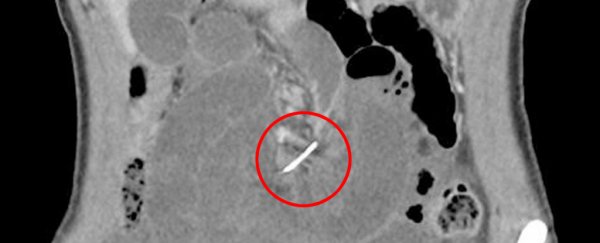Doctors at a hospital in Australia were bewildered when a 30-year-old woman showed up with intense stomach pains.
Her heart rate was faster than normal, and the membrane lining her abdominal wall was inflamed, one of her doctors wrote in a medical article published Monday by BMJ Case Reports. But her vital signs, laboratory tests, ultrasound and a scan of her liver, gallbladder and bile ducts were all normal.
The woman also had not had surgery recently, which eliminated the possibility that a surgeon accidentally left a foreign object inside her, according to Popular Science.
But a CT scan revealed that a thin, metallic wire was lodged in her intestines.
And it had been there for at least a decade.
That object, a little more than 2.5 inches (6.35 cm) long, was a dental brace wire that the woman used to wear, according to her doctors.
It caused her intestine "to twist around on itself - a condition known as volvulus," according to a news release from BMJ Case Reports, an online collection of articles and case reports submitted by health-care professionals and researchers.
The woman told doctors that she wore braces 10 years ago and has removed them since. She also said she does not remember ingesting the wire or losing part of her braces, wrote Talia Shepherd, one of the physicians who treated the woman at Sir Charles Gairdner Hospital in Nedlands in Western Australia.
"The case is so unique is because normally if you swallow something like that, it presents earlier," Shepherd told Popular Science.
More typically, people unknowingly ingest things like fish bones instead of metallic objects, Shepherd said. And they usually realise it shortly after. In the woman's case, she didn't experience any pain until recently.
"We were all a bit dumbfounded," Shepherd told the magazine. "It wasn't what I was expecting to find at all."
Accidentally ingesting foreign objects is not unheard of.
Last May, Live Science published a list of "11 Weird Things People Have Swallowed." It included small and pointed objects like a bobby pin and a dental instrument, as well as larger ones like a cellphone, a pen, a lighter and a tooth brush.
In a 2015 medical case from Saudi Arabia, doctors examining an X-ray of a 16-month-old boy's esophagus came face-to-face with an image of a smiling SpongeBob SquarePants.
Ghofran Ageely, a radiology resident at King Abdulaziz University Hospital in Jiddah, Saudi Arabia, told Live Science that the toddler had swallowed his older sister's SpongeBob pendant.
Ageely said she initially thought it was a pin or a hair accessory because an X-ray of the child's body from the side showed a thin object in his esophagus. She was shocked after looking at the frontal view.
"'SpongeBob,' I screamed!!!" Ageely told Live Science in an email. "I was amazed by the visible details. You can see the freckles, shoes and fingers .. AMAZING."
Last May, a Texas mother warned other parents after her daughter accidentally swallowed a fidget spinner. They were in a car when she noticed her daughter choking, Kelly Rose Joniec wrote on her Facebook page, according to USA Today.
A recent report by a consumer watchdog group warned parents of the dangers of the popular toy, which it said has "the potential to lead to tragic or deadly consequences."
As for the woman from Australia, Shepherd said she recovered well.
2017 © The Washington Post
This article was originally published by The Washington Post.
